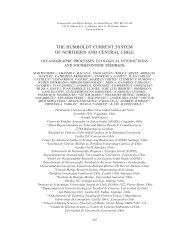The ecology of rafting in the marine environment - Bedim
The ecology of rafting in the marine environment - Bedim
The ecology of rafting in the marine environment - Bedim
Create successful ePaper yourself
Turn your PDF publications into a flip-book with our unique Google optimized e-Paper software.
RAFTING OF BENTHIC MARINE ORGANISMS<br />
Table 9 (cont<strong>in</strong>ued) Arthropoda Malacostraca reported or <strong>in</strong>ferred as <strong>raft<strong>in</strong>g</strong><br />
Species Region<br />
(Davenport & Rees 1993, M. Thiel, personal observation). Also juvenile portunid crabs may occur<br />
<strong>in</strong> high abundances on float<strong>in</strong>g macroalgae (Tanigawa 2001).<br />
Adults from <strong>the</strong> genus Plagusia can frequently be found on float<strong>in</strong>g items (Schubart et al.<br />
2001). <strong>The</strong> species P. depressa and P. squamosa from <strong>the</strong> Atlantic and Indo-Pacific, respectively,<br />
are very similar <strong>in</strong> morphology and only recent molecular studies revealed that <strong>the</strong>y are two dist<strong>in</strong>ct<br />
species (Schubart et al. 2001). <strong>The</strong> authors concluded that despite <strong>the</strong> high dispersal capabilities<br />
<strong>of</strong> <strong>the</strong>se species, exchange between <strong>the</strong> Indo-Pacific and Atlantic oceans around <strong>the</strong> sou<strong>the</strong>rn tips<br />
<strong>of</strong> <strong>the</strong> major cont<strong>in</strong>ents has not occurred.<br />
Some decapods are obligate rafters. Species from <strong>the</strong> genus Planes colonise a variety <strong>of</strong> float<strong>in</strong>g<br />
objects rang<strong>in</strong>g from float<strong>in</strong>g Sargassum (Hitchcock 1941, Sano et al. 2003) over tree trunks and<br />
buoys (Chace 1966, Jara & Jaramillo 1979) to sea turtles (Dell<strong>in</strong>ger et al. 1997). Davenport (1992)<br />
reported high abundances <strong>of</strong> Planes m<strong>in</strong>utus on Sargassum rafts. Population densities <strong>of</strong> Planes<br />
m<strong>in</strong>utus are l<strong>in</strong>ked to <strong>the</strong> quantity <strong>of</strong> float<strong>in</strong>g substrata because this crab has never been collected<br />
from waters free <strong>of</strong> float<strong>in</strong>g items. <strong>The</strong> fact that crabs on wood and o<strong>the</strong>r flotsam are usually small<br />
and non-reproductive suggests that <strong>the</strong>se items represent secondary habitats and that turtles are <strong>the</strong><br />
preferred habitat <strong>of</strong> <strong>the</strong>se crabs. Ano<strong>the</strong>r obligate rafter is Pachygrapsus mar<strong>in</strong>us. This species is<br />
found on flotsam <strong>in</strong> <strong>the</strong> Pacific (Chace 1951). It has been found among a dense growth <strong>of</strong> stalked<br />
barnacles (Lepas sp.) on a large glass fish<strong>in</strong>g float (Dell 1964). Van der Baan et al. (1972) expla<strong>in</strong>ed<br />
<strong>the</strong> occurrence <strong>of</strong> Macropodia sp. and Hyas araneus <strong>in</strong> <strong>the</strong> neuston <strong>of</strong>f <strong>the</strong> Dutch coast with an<br />
association <strong>of</strong> <strong>the</strong> animals with float<strong>in</strong>g seaweed accumulat<strong>in</strong>g at <strong>the</strong> hull <strong>of</strong> a lightship. On <strong>the</strong><br />
Great Barrier Reef crabs <strong>of</strong> <strong>the</strong> species Thalamita stimpsoni have been found <strong>raft<strong>in</strong>g</strong> on buoyant<br />
corals (DeVantier 1992).<br />
Genetic distance between Hawaiian and Panamanian populations <strong>of</strong> <strong>the</strong> brachyuran crab Trapezia<br />
ferrug<strong>in</strong>ea did not differ significantly from zero (Huber 1985) <strong>in</strong>dicat<strong>in</strong>g ei<strong>the</strong>r that <strong>the</strong> eastern<br />
population had recently immigrated from <strong>the</strong> central Pacific, or that <strong>the</strong>re exists gene flow between<br />
<strong>the</strong> two regions. Long-distance dispersal between <strong>the</strong> two locations was considered impossible<br />
because <strong>the</strong> duration <strong>of</strong> larval development <strong>of</strong> this species is too short. Even though <strong>the</strong> author<br />
does not mention <strong>the</strong> possibility <strong>of</strong> population connection by <strong>raft<strong>in</strong>g</strong>, this mechanism is not unlikely<br />
because Trapezia ferrug<strong>in</strong>ea is a common symbiont <strong>of</strong> corals from <strong>the</strong> genus Pocillopora, which<br />
have repeatedly been observed <strong>raft<strong>in</strong>g</strong> (Jokiel 1984).<br />
Caridean and peneid shrimp are also frequently found on float<strong>in</strong>g macroalgae (Hirosaki 1964,<br />
K<strong>in</strong>gsford & Choat 1985, Hobday 2000a). Some species from <strong>the</strong> Sargassum community spend<br />
<strong>the</strong>ir entire life cycle on float<strong>in</strong>g algae (Butler et al. 1983, Hacker & Mad<strong>in</strong> 1991). Most species<br />
are grazers that feed on <strong>the</strong>ir float<strong>in</strong>g substratum. While mar<strong>in</strong>e decapods are frequently found on<br />
float<strong>in</strong>g items, Marcus (1926) and Wittmann (1934) precluded large-scale dispersal <strong>of</strong> freshwater<br />
crabs over entire oceans for physiological reasons.<br />
325<br />
Raft<strong>in</strong>g<br />
<strong>in</strong>ference<br />
Float<strong>in</strong>g<br />
substratum Reference<br />
Tanais dulongii Azores C M Morton & Britton 2000<br />
Tanais stanfordi Galapagos D n.i. Peck 1994<br />
Notes: B = stranded float<strong>in</strong>g item on beach; C = circumstantial; D = distributional <strong>in</strong>ference; G = genetic <strong>in</strong>ference; M =<br />
macroalgae; n.i. = no <strong>in</strong>formation; O = o<strong>the</strong>r; P = plastics; R = <strong>raft<strong>in</strong>g</strong>; S = seeds; T = tar lumps; W = wood.<br />
* References refer to this species under a different name.










